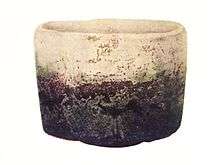Chawan
_with_Hare's_Fur_Pattern_LACMA_M.51.2.1.jpg)
A chawan (茶碗; literally "tea bowl") is a bowl used for preparing and drinking tea. There are many types of chawan used in East Asian tea ceremonies. The choice of their use depends upon many considerations.
History

The chawan originated in China. The earliest chawan in Japan were imported from China between the 13th through the 16th century.[1]
The Jian chawan, a Chinese tea bowl known as Tenmoku chawan in Japan, was the preferred tea bowl for the Japanese tea ceremony up until the 16th century.[2] In Japan, tea was also mainly drunk from this Chinese variety of tea bowls up till about the 15th century.[3] The Japanese term tenmoku is derived from the name of the Tianmu Mountain, where Japanese priests acquired these tea bowls from Chinese temples to bring back to Japan according to tradition.[4]
An 11th-century resident of Fujian wrote about the Jian tea wares:
| “ | Tea is of light colour and looks best in black cups. The cups made at Jianyang are bluish-black in colour, marked like the fur of a hare. Being of rather thick fabric they retain the heat, so that when once warmed through they cool very slowly, and they are additionally valued on this account. None of the cups produced at other places can rival these. Blue and white cups are not used by those who give tea-tasting parties.[5] | ” |
By the end of the Kamakura period (1185–1333), as the custom of tea drinking spread throughout Japan and the Tenmoku chawan became desired by all ranks of society, the Japanese began to make their own copies in Seto (in present-day Aichi Prefecture).[6] Although the Tenmoku chawan was derived from the original Chinese that came in various colors, shapes, and designs, the Japanese particularly liked the bowls with a tapered shape, so most Seto-made Tenmoku chawan had this shape.[6]
With the rise of the wabi tea ceremony in the late Muromachi period (1336–1573), the Ido chawan, a variety of Korean bowls mainly used for rice in Korea, also became highly prized in Japan.[3] Korean bowls were a favourite of Sen no Rikyu because of their rough simplicity.[7]
With time and development of the Japanese tea ceremony as a distinct form, local ceramics became more priced and developed. Around the Edo period, the chawan was often made in Japan. The most esteemed pieces for a tea ceremony chawan are Raku ware, Hagi ware and Karatsu ware. There is a saying in the tea ceremony schools for the preferred types of chawan: "Raku first, Hagi second, Karatsu third."[8]
Another chawan type that became slightly popular during the Edo period from abroad was the Annan ware from Vietnam, which were originally used there as rice bowls. Annan ware is blue and white, with a high foot.
Types
Chawan have various shapes:[9]
- 鉄鉢形, Wa-nari: Circle shape
- 椀形, Wan-nari: Wooden Bowl shape
- 呉記型, Goki-gata: Goki type
- 半筒型, Han tsutsu-gata: Half Cylinder shape
- 筒型, Tsutsu-gata: Cylinder type
- 碁笥底型, Gokezoko-gata: Go Stone Box type
- 胴締, Dojimari-gata: Waist type
- 馬上杯, Bajyohai: Rider's Cup
- 杉形, Sugi-nari: Cedar shape
- 井戸型, Ido-gata: Ido or Well type
- 天目型, Tenmoku-gata: Tenmoku type
- Komogai-nari: Komogai Shape
- 端反り型, Hatazori-gata: Curving Lip type
- 平形, Hiragata: Flat shape
- 馬盥, Badarai: Horse Bucket shape
- 沓形, Kutsu-gata: Clog or Shoe shape
- 砂浜形, Suhama-gata: Shoreline type
- 桃形, Momo-gata: Peach shape
- 筆洗形, Hissen-gata: Brush Washer shape
- 編笠, Amikasa: Amikasa Straw Hat type
- 三角形, Sankaku-gata: Triangular shape
- 四方形, Shiho-gata: Four Sided shape
See also
- List of Japanese tea ceremony utensils
- Yunomi, teacups used in Japan for everyday use
References
- ↑ Kodansha encyclopedia of Japan, Volume 2. Tokyo: Kodansha. 1983. p. 25. ISBN 978-0-87011-622-3.
- ↑ "Jian ware". Encyclopædia Britannica. Retrieved 4 December 2011.
- 1 2 Tsuchiya, Yoshio (2002). The fine art of Japanese food arrangement. London: Kodansha Europe Ltd. p. 67. ISBN 978-4-7700-2930-0.
- ↑ "Tea bowl (China) (91.1.226)". Heilbrunn Timeline of Art History. New York: The Metropolitan Museum of Art. October 2006.
- ↑ Bushell, S.W. (1977). Chinese pottery and porcelain. Kuala Lumpur: Oxford University Press. ISBN 0-19-580372-8.
- 1 2 Ono, Yoshihiro; Rinne, Melissa M. "Tenmoku Teabowls". Kyoto National Museum. Retrieved 26 November 2011.
- ↑ Sadler, A.L. Cha-No-Yu: The Japanese Tea Ceremony. Tokyo: Tuttle, 1962, 67.
- ↑ http://www.japantimes.co.jp/culture/2000/01/22/arts/veteran-of-hagi-continues-rediscovery/#.V7HUAluLS_4
- ↑ http://flyeschool.com/content/japanese-tea-bowl-shapes
External links
![]() Media related to Chawan at Wikimedia Commons
Media related to Chawan at Wikimedia Commons
- JNT, Joy of the Noble Teacup: International Chawan Exhibition
- Official pages of the international traveling Chawan Exhibition
- A Handbook of Chinese Ceramics from The Metropolitan Museum of Art